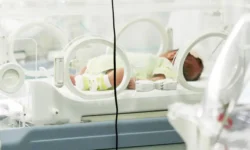Learn about risk factors, treatment and how to get help for your child and family
In a perfect world, no baby would get sick in the first few weeks of life. Although rare, necrotizing enterocolitis (NEC) affects about 1 in 1,000 premature babies and 1 in 10,000 full-term babies, according to the Cleveland Clinic. Sadly, this condition strikes premature babies the most, and developing NEC can have dire consequences for a baby whose body is already struggling to survive.
Many parents have never heard of this condition, and you may be left feeling lost and confused if it happens to your baby. Learning more about NEC and how medical professionals play a role in the outcome of the condition can help you begin to make the best possible decisions for your baby and your family.
What are the risk factors for developing necrotizing enterocolitis?
Necrotizing enterocolitis often results from impaired blood circulation that damages the baby’s intestines and allows bacteria to build up and enter their intestinal walls.
Being born prematurely is the biggest risk factor for developing NEC. However, there are other factors that medical professionals should watch out for to know if a baby might develop this infection.
Babies who experience a difficult delivery in which they are deprived of oxygen during the birthing process are more likely to develop NEC. Formula-fed babies and those with other gastrointestinal infections also have a higher risk of getting sick.
Types of necrotizing enterocolitis
There are 4 main types of necrotizing enterocolitis:
- Classic. The most common type in which babies usually don’t show symptoms until their 3rd to 6th week of life.
- Transfusion-associated. Resulting from a blood transfusion, babies typically show symptoms within a few days of the transfusion.
- Atypical. Although rare, some babies develop symptoms within the first week after birth, even before their first feeding.
- Term infant. In full-term babies, NCE is often the result of a birth defect or other issue such as low oxygen levels at birth.
What are the symptoms of necrotizing enterocolitis?
Babies can progress rapidly through the necrotizing enterocolitis stages, which is why medical professionals need to stay alert for the following symptoms:
- Difficulty feeding
- Signs of abdominal pain or discomfort
- Bloating
- Vomiting green-yellow bile
- Diarrhea
- Bloody stool
- Lethargy
- Low blood pressure
- Shock
What treatments are available for babies with NEC?
For most babies, necrotizing enterocolitis treatment is based on their age and severity of the disease. Antibiotics are often used to help the baby’s body fight the infection. Feedings may need to be stopped temporarily, and an IV may be administered to provide hydration and nutrition to the newborn. Nasogastric tubes are also commonly used to help keep the baby’s stomach empty.
In severe cases, babies may need surgical treatments to remove a portion of the diseased intestine.
Can medical malpractice cause or worsen NEC?
Medical professionals have several vital opportunities to help prevent NEC from occurring and stop it from progressing to a severe level if it does occur. If a pregnant woman shows signs of premature labor, her medical team should do everything they can to help stop it. This might include strategies such as bed rest or medications to stop the labor.
When a premature birth is imminent, a doctor may give the pregnant mother medication to help speed up the development of the baby’s vital organs. During labor, a doctor should also continue to monitor the baby for signs of distress that could disrupt the flow of oxygen throughout their body.
After the baby is born, doctors should watch for necrotizing enterocolitis symptoms so they can immediately begin treatments to prevent severe disease from damaging the baby’s intestines.
What are the long-term outcomes of NEC?
With proper care, many babies can make a full recovery.
Unfortunately, allowing the infection to worsen without treatment can lead to long-term consequences. The long-term effects of NEC can include scarring and narrowing of the intestines. Without proper intervention, a baby’s intestines may become so damaged that they can no longer absorb nutrients properly. In a worst-case scenario, NEC could lead to the need for a bowel transplant or even death.
When should you consult a birth injury lawyer?
All medical professionals are expected to watch for symptoms of developing medical conditions, especially during times when a baby is most vulnerable. A baby born prematurely already has a high risk for developing NEC, which means that the doctor and other members of the medical team should constantly be monitoring for symptoms.
If a baby displays signs of NEC, testing and treatment should begin immediately. If you believe a medical professional failed to provide proper care at any point during your pregnancy, labor, delivery or after your baby was born, it’s best to consult a birth injury lawyer near you right away.
While the majority of babies with NEC survive, the condition can continue to impact the rest of their lives.
After watching your baby struggle during their first few days of life, you may be feeling overwhelmed and unsure what to do next. Reaching out to experienced birth injury attorneys like Laura Brown can help give you peace of mind that you’ve done everything possible to protect your baby’s wellbeing and prospects for a healthy future.
- Cerebral Palsy
- Caput Succedaneum and Cephalohematoma
- Neonatal Intracranial Hemorrhage (Childbirth Brain Bleeds)
- Hydrocephalus (Extra Fluid in the Brain Cavity)
- Cervical Dystonia
- Hemiplegia (Brain or Spinal Cord Injury)
- Hemorrhagic Stroke
- Neonatal Stroke
- HIE
- Periventricular Leukomalacia (PVL) Brain Injury
- Infant Seizures
- Spastic Diplegia (Spasticity in the Legs)
- Top Risks for Birth Injuries
- Fetal Alcohol Syndrome
- Facial Paralysis
- Spinal Cord Injuries
- Bell’s Palsy
- Brachial Plexus Nerves & Erb’s Palsy
- Klumpke’s Palsy
- G-Tubes for Newborns
- Medical Errors
- Cesarean Section & Birth Injury
- Negligence in Brain Cooling Treatment
- Craniosacral Therapy
- Occupational Therapy
- Speech Therapy
- Transition From Pediatric to Adult Healthcare
- Surgical Options for Spastic Cerebral Palsy
- Fetal Intolerance to Labor
- Jaundice (Kernicterus)
- Breech Position
- Placental Complications
- Umbilical Cord Problems
- Uterine Rupture
- Cervical Incompetence (Insufficiency)
- Blighted Ovum
- Necrotizing Enterocolitis (NEC) - Intestinal Inflammation
- Cephalopelvic Disproportion
- Meconium Aspiration Syndrome
- Amniotic Fluid Embolism
- Birth Injury from Premature Delivery
- Developmental Delays
- Abnormal Cord Insertion
- Infections at Birth
- Chorioamnionitis Bacterial Infection
- Premature birth
- Oxygen Deprivation
- Listeria
- Birth-Acquired Herpes
- Placenta Previa
- Placental Abruption
- Mismanaged Fetal Malposition
- Rapid Labor
- Obesity Related Birth Injuries
- Intrauterine Growth Restriction
- Blood Clots During Pregnancy
- Ectopic Pregnancy Misdiagnosis
- Myths & Facts About Birth Injuries
- Bacterial Vaginosis
- Gestational Diabetes
- Maternal Mortality Risk
- Oligohydramnios (Low Amniotic Fluid)
- Infections During Pregnancy
- Excessive Bleeding During Pregnancy
- Congenital Syphilis


